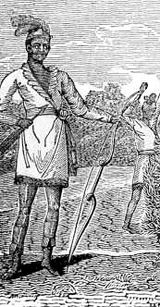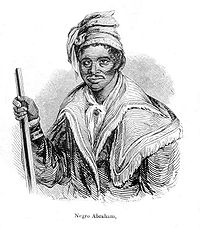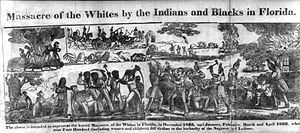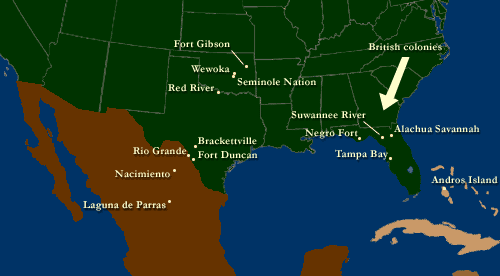
Black Seminoles
Background Information
SOS Children have produced a selection of wikipedia articles for schools since 2005. A quick link for child sponsorship is http://www.sponsor-a-child.org.uk/
The Black Seminoles is a term used by modern historians for the descendants of free blacks and some runaway slaves ( maroons), mostly Gullahs who escaped from coastal South Carolina and Georgia rice plantations into the Spanish Florida wilderness beginning as early as the late 17th century. By the early 19th century, they had often formed communities near the Seminole Indians.
Together, the two groups formed a multi-ethnic and bi-racial alliance. Today, Black Seminole descendants still live in Florida, rural communities in Oklahoma and Texas, and in the Bahamas and Northern Mexico. In the 19th century, the Florida "Black Seminoles" were called "Seminole Negroes" by their white American enemies and Estelusti (Black People), by their Indian allies. Modern Black Seminoles are known as "Seminole Freedmen" in Oklahoma, "Black Indians" in the Bahamas, and Mascogos in Mexico. The Black Seminole Scouts served in the United States Army during the 19th century.
Origins
The Spanish strategy for defending their claim of Florida at first was based on organizing the indigenous people into a mission system. The mission Native Americans were to serve as militia to protect the colony from English incursions from the north. But a combination of raids by South Carolina colonists and new European infectious diseases, to which they did not have immunity, decimated Florida's native population. After the local Native Americans had all but died out, Spanish authorities encouraged renegade Native Americans and runaway slaves from England's southern colonies to move south. The Spanish were hoping that these traditional enemies of the English would prove effective in holding off English expansion.
As early as 1689, African slaves fled from the South Carolina Lowcountry to Spanish Florida seeking freedom. Under an edict from King Charles II of Spain in 1693, the black fugitives received liberty in exchange for defending the Spanish settlers at St. Augustine. The Spanish organized the black volunteers into a militia; their settlement at Fort Mose, founded in 1738, was the first legally sanctioned free black town in North America.
Not all the slaves escaping south found military service in St. Augustine to their liking. It is likely that many more runaway slaves sought refuge in wilderness areas in Northern Florida where their knowledge of tropical agriculture—and resistance to tropical diseases—served them well. Most of the blacks who pioneered Florida were Gullah people who escaped from the rice plantations in South Carolina (and later Georgia). As Gullah, they had preserved much of their African language in an Afro-English based Creole, along with cultural practices and African leadership structure. The Gullah pioneers built their own settlements based on rice and corn agriculture. They were allies to Indians escaping into Florida at the same time.
In 1763 the British took over rule in Florida, in an exchange of territory with the Spanish west of the Mississippi, of former French lands. The area was still considered a sanctuary for fugitive slaves, as it was lightly settled, and many sought refuge near growing American Indian settlements.
Florida had been a refuge for runaway slaves for at least 70 years by the time of the American Revolution. Communities of Black Seminoles were established on the outskirts of major Seminole towns. A new influx of freedom-seeking blacks reached Florida during the American Revolution (1775–83). Several thousand American slaves agreed to fight for the British in exchange for liberty and were called black Loyalists. Those who chose freedom and resettlement were evacuated by the British along with their own troops from southern cities such as Charleston, as well as New York, and transported to the Caribbean, New Brunswick and England. (Florida was under British control throughout the conflict.) During the Revolution, Seminole Indians also allied with the British, and Africans and Seminole came into increased contact with each other.
In addition, members of both communities sided with the British against the US during the War of 1812, solidifying ties and earning the enmity of the war's American General Andrew Jackson.
When Africans and the Seminole first started to interact, the Native Americans of various tribes were also recent migrants to Florida. Spain gave land to some Muscogee (Creek) Native Americans. Over time the Creek were joined by other remnant groups of Southeast American Indians, such as the Miccosukee and the Apalachicola, and formed communities. Their community evolved over the late 18th and early 19th centuries as waves of Creek left present-day Georgia and Alabama under pressure from white settlement and the Creek Wars.
By the time the American naturalist William Bartram visited the area in 1773, the Seminole had their own tribal name, derived from cimarron, the Spanish word for runaway, which connoted the tribe's breakaway status from the Creek. Cimarron was also the source of the English word maroon, used to describe the runaway slave communities of Florida, the Great Dismal Swamp maroons in today's North Carolina and Virginia, the Caribbean, and other parts of the New World.
Culture
The Black Seminole culture that took shape after 1800 was a dynamic mixture of African, Native American, Spanish, and slave traditions. Adopting certain practices of the Native Americans, maroons wore Seminole clothing; strained koonti, a native root; and made sofkee, a paste created by mashing corn with a mortar and pestle.
Initially living apart from the Native Americans, the maroons developed their own unique African-American culture. Black Seminoles inclined toward a syncretic form of Christianity developed during the plantation years. Certain cultural practices, such as " jumping the broom" to celebrate marriage, hailed from the plantations; other customs, such as some names used for black towns, reflected African heritage.
As time progressed, the Seminole and Blacks had some intermarriage, but historians and anthropologists have come to believe that generally the Black Seminoles had independent communities. They allied with the Seminole at times of war. The Seminole known as King Phillip was known to have married a Black Seminole woman and had a mixed-race child with her. The Southeast Indians generally had matrilineal systems, in which they believed that children belonged to the mother's clan. While the children might integrate customs from both cultures, the Seminole believed them to belong to the mother's group more than the father's. Under the principle of partus sequitur ventrem, adopted in slavery law in the colonies, the children of mixed unions took the mother's social status, so any children born to a slave were also considered slaves, even if the parent had escaped.
African-Seminole relations
By the early 19th century, maroons (free blacks and runaway slaves) and the Seminole were in regular contact in Florida, where they evolved a system of relations unique among North American Native Americans and blacks. In exchange for paying an annual tribute of livestock and crops, black prisoners or slaves found sanctuary among the Seminole. Seminoles, in turn, acquired an important strategic ally in a sparsely populated region.
Typically, many or most members of the Black Seminole communities were not identified as slaves of individual Native American chiefs. Black Seminoles lived in their own independent communities, elected their own leaders, and could amass wealth in cattle and crops. Most importantly, they bore arms for self-defense. Florida real estate records show that the Seminole and Black Seminole people owned large quantities of Florida land. In some cases, a portion of that Florida land is still owned by the Seminole and Black Seminole descendants in Florida.
Under the comparatively free conditions, the Black Seminoles flourished. U.S. Army Lieutenant George McCall recorded his impressions of a Black Seminole community in 1826:
We found these negroes in possession of large fields of the finest land, producing large crops of corn, beans, melons, pumpkins, and other esculent vegetables. ... I saw, while riding along the borders of the ponds, fine rice growing; and in the village large corn-cribs were filled, while the houses were larger and more comfortable than those of the Indians themselves.
During the 1820's, it was estimated that 800 blacks were living with the Seminoles. The Black Seminole settlements were overall highly militarized, unlike the communities of most of the slaves in the Deep South. The military nature of the African-Seminole relationship led General Edmund Pendleton Gaines, who visited several flourishing Black Seminole settlements in the 1800s, to describe the African Americans as "vassals and allies" of the Seminole.
In terms of spirituality, the ethnic groups remained distinct. The Seminole followed the nativistic principles of their Great Spirit. Blacks had a syncretic form of Christianity inherited from the plantations. In general, the blacks never wholly adopted Seminole culture and beliefs, nor were they accepted into Native American society. Though later generations of Seminole descended from white and Indian mixtures would not consider the black members of their society to be "Seminole", culturally the mixed Black Seminoles were all but entirely absorbed into the native population.
Most of the blacks spoke Gullah, an Afro-English-based creole language, so they often could communicate better with Anglo-Americans which the Seminole Indians took advantage of. They used them as translators which advanced the trading system that had been created with the British and other tribes. Together in Florida they developed Afro-Seminole Creole, identified as a distinct language in 1978 by the linguist Ian Hancock, who found that Black Seminole and Seminole elders still spoke it in some locations.
Seminole Wars
From the time of the Revolution, the armed black communities in Florida was a major concern for American slave owners. Slaveholders sought the return of Florida's black fugitives under the Treaty of New York (1790), the first treaty ratified after the adoption of the United States Constitution. General Andrew Jackson wanted to disrupt Florida's maroon communities in 1816 and attacked the Negro Fort, which had become a Black Seminole stronghold after the British left Florida. Breaking up the maroon communities was one of Jackson's major objectives in the First Seminole War (1817–18).
The Second Seminole War (1835–42) marked the height of tension between the U.S. and the Black Seminoles, and also the historical peak of the African-Seminole alliance. Under the policy of Indian removal, the US wanted to relocate to the western Indian Territory Florida's 4,000 Seminole people and a portion of their 800 Black Seminole allies. During the year before the war, prominent white citizens captured and claimed at least 100 Black Seminoles as runaway slaves.
Anticipating attempts to re-enslave more members of their community, Black Seminoles opposed relocation. In councils before the war, they threw their support behind the most militant Seminole faction, led by Osceola. After war broke out, individual black leaders, such as John Caesar, Abraham, and John Horse, played key roles. In addition to aiding the Indians in their fight, Black Seminoles recruited plantation slaves to rebellion at the start of the war. The slaves joined Indians and maroons in the destruction of 21 sugar plantations from December 25, 1835, through the summer of 1836. Historians do not agree on whether these events should be considered a separate slave rebellion; generally they view the attacks on the sugar plantations as part of the Seminole War.
By 1838, U.S. General Thomas Sydney Jesup tried to divide the black and Seminole warriors by offering promises of freedom to the blacks if they surrendered and agreed to removal to Indian Territory. John Horse was among the black warriors who surrendered under this condition. Due to Seminole opposition, however, the Army did not fully follow through on its offer. The status of Black Seminoles and fugitive slaves was largely still unsettled after they reached Indian Territory. The issue was compounded by the government's initially putting the Seminole and blacks under the administration of the Creek Nation, whose people were slaveholders. They tried to re-enslave some of the fugitive black slaves.
In the West
After 1838, more than 500 Black Seminoles walked with the Seminoles thousands of miles to the Indian Territory in present-day Oklahoma. Because of harsh conditions, many of both peoples died along this trail from Florida to Oklahoma, also known as The Trail of Tears.
Despite U.S. Army promises of freedom, in the west the Black Seminoles were still threatened by slave raiders. These included pro-slavery members of the Creek tribe and some former Seminole allies, whose allegiance to the blacks diminished after defeat by the US in the war. Officers of the federal army may have tried to protect the Black Seminoles, but in 1848 the U.S. Attorney General bowed to pro-slavery lobbyists and ordered the army to disarm them. This left hundreds of Seminoles and Black Seminoles unable to leave the settlement or to defend themselves against slavers.
Facing enslavement, a Black Seminole leader named John Horse and about 100 Black Seminoles staged a mass escape in 1849 to Mexico, where slavery had been abolished twenty years earlier. The black fugitives crossed to freedom in July 1850. They rode with a faction of traditionalist Seminoles under the Indian chief Coacochee, who led the expedition. The Mexican government welcomed the Seminole allies as border guards on the frontier.
For the next 20 years, Black Seminoles served as militiamen and Indian fighters in Mexico, where they became known as los mascogos. Slave raiders from Texas continued to threaten the community. Arms and reinforcements from the Mexican Army enabled the black warriors to defend themselves.
Throughout the period, several hundred Black Seminoles remained in the Indian Territory (present-day Oklahoma). Because most of the Seminole supported the Confederacy during the American Civil War, the US required a new peace treaty with them and the other of the Five Civilized Tribes. The US required the emancipation of slaves and extension to them of full citizenship rights in the tribes. In Oklahoma, Black Seminoles became known as Seminole Freedmen, although most had not been living as slaves before the war. They lived —as their descendants still do— in and around Wewoka, Oklahoma, the community founded by John Horse as a black settlement in 1849. Today it is the capital of the Seminole Nation of Oklahoma.
In 1870, the U.S. Army invited Black Seminoles to return from Mexico to serve as army scouts for the United States. The Seminole Negro Indian Scouts (originally a black unit despite the name) played a lead role in the Texas Indian Wars of the 1870s. The scouts became famous for their tracking abilities and feats of endurance. Four men were awarded the Medal of Honour. They served as advance scouts for the commanding white officers and the all-black units known as the Buffalo Soldiers, with whom they were closely associated. After the close of the Texas Indian Wars, the scouts remained stationed at Fort Clark in Brackettville, Texas, until the army disbanded them in 1914. Family members settled in and around Brackettville, and scouts and family members were buried in its cemetery. The town remains the spiritual centre of the Texas-based Black Seminoles.
The black Seminole community in Nacimiento, Coahuila, inhabits lands adjacent to the Kickapoo tribe. Descendants of another Black Seminole community reside half a continent away on Andros Island in the Bahamas. Refugees from 19th-century Florida wars went to the British-held islands to find sanctuary from American enslavement. By that time Great Britain had abolished slavery.
Some descendants of the Black Seminoles who did not emigrate still live in Florida today. For the most part, these Black Seminoles are not members of registered tribes, either the Seminole Tribe of Florida or the Miccosukee Tribe of Florida.
Seminole Freedmen exclusion controversy
In the 1990s and early 2000s (decade), Seminole Freedmen in Oklahoma were in the national news because of a legal dispute with the Seminole Nation of Oklahoma over membership and rights within the tribe. Black Seminoles believed that due to their ancestral descent from the tribe, they should be included in services provided by a $56 million federal settlement, a judgment trust, awarded to the Seminole Nation because of land taken from them by the United States at their removal from Florida. As the judgment trust was based on the tribe as it existed in 1823, when Black Seminoles did not have citizenship rights, Seminole Freedmen were excluded from the benefits. Many Black Seminoles had held and farmed land in Florida, and suffered property losses equal to the Seminole as a result of US actions.
In another aspect of the dispute over citizenship, in 2000 the Seminole Nation voted to exclude as members any Seminole Freedmen who did not have an Indian ancestor listed on the Dawes Rolls, the federal registry established in the early 20th century. At the time during rushed conditions, registrars had frequently listed Seminoles with visible African ancestry as Freedmen, regardless of their proportion of Indian ancestry or whether they were considered members of the tribe. This excluded some Black Seminole from being listed on the Indian-Seminole list, although they qualified by ancestry. In addition, because the Dawes Rolls included many Intermarried Whites who lived on Indian lands, but did not include blacks, the Seminole Freedmen believed the tribe's 21st-century decision was racially based and opposed it on those grounds. The Seminole Freedmen brought suit against the nation, but as of 2002, they did not succeed in the courts.
The Seminole Indians had voted to exclude any Seminole Freedmen without documented Indian descent from inclusion in the settlement and membership in the tribe. In June 2004, the U.S. Supreme Court refused to allow the Seminole Freedmen to sue the federal government for inclusion in the settlement unless they could obtain the Seminole Nation's consent, as the latter has status as a sovereign nation.
Later that year, the Bureau of Indian Affairs held that the exclusion of Black Seminoles constituted a violation of the Seminole Nation's 1866 treaty with the United States. They noted that the treaty was made with a tribe that included black as well as white and brown members. The treaty had required the Seminole to give the Seminole Freedmen full citizenship and voting rights in the tribe. The BIA rescinded all federal funding for services and programs to Seminole, prompting the tribe's members to change their decision on membership. In 2004 the Nation voted to include the Freedmen in the tribe for voting in all elections and sharing in allotments and settlements. Journalists theorized the decision could affect the similar case in which Cherokee Freedmen had been excluded from the Cherokee unless they could document a direct Indian ancestor on the Dawes Rolls.




